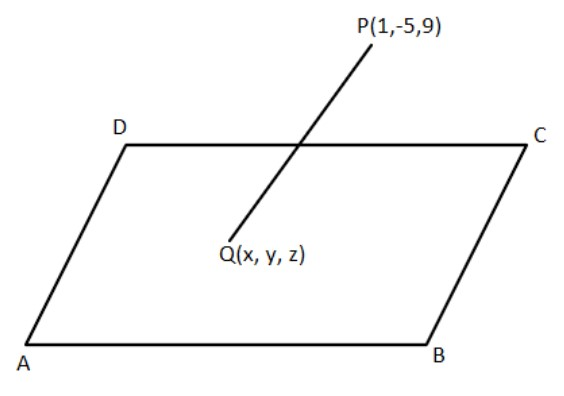Question
Question: The distance of a point \(\left( {1, - 5,9} \right)\) from the plane \(x - y + z = 5\) measured alon...
The distance of a point (1,−5,9) from the plane x−y+z=5 measured along the line x=y=z is
A) 310
B) 103
C) 310
D) 320
Solution
Here we can write the equation of the line as point is given (1,−5,9). And direction ratio is also given as (1,1,1). So equation is written by
ax−x1=by−y1=cz−z1 where (x,y,z) are the points and (a,b,c) are the direction ratios.Using this equation we find the coordinate points on the plane then finally we calculate distance between these two points which is our required answer.
Complete step-by-step answer:
Here, a plane is given x−y+z=5 and a point anywhere is given (1,−5,9) which is to be measured along the line x=y=z. So if we draw the diagram, it seems like this:

So here, ABCD is a plane satisfying x−y+z=5 and Q is the point on this plane and P is the given point and PQ is the line along x=y=z.
So we need to find PQ.
So for that we need to find the coordinates of Q.
Here the point P(x1,y1,z1)=(1,−5,9) is given. And the point Q(x,y,z) is assumed.
And we are given that PQ is along the line x=y=z, that means we are given a direction ratio, that is (1,1,1).
So equation of line PQ must be written as
(dr)1x−x1=(dr)2y−y1=(dr)3z−z1
Here dr is the direction ratio.
So, 1x−1=1y+5=1z−9=λ
Let this be equal to λ
So, here we can equate,
1x−1=λ 1y+5=λ 1z−9=λ
So,
x=λ+1 y=λ−5 z=λ+9
Here, (x,y,z) lies on the plane ABCD so it must satisfy the equation x−y+z=5
So by putting (x,y,z) values,
λ+1−λ+5+λ+9=5 λ=−10
So now we get λ=−10.
Now,
x=λ+1=−10+1=−9 y=λ−5=−10−5=−15 z=λ+9=−10+9=−1
So, we got, Q(x,y,z)=(−9,−15,−1)
Now by distance formula, we can find PQ
PQ=(x−x1)2+(y−y1)2+(z−z1)2
Here, P(x1,y1,z1)=(1,−5,9)
And Q(x,y,z)=(−9,−15,−1)
So,
PQ=(−9−1)2+(−15+5)2+(−1−9)2 =(−10)2+(−10)2+(−10)2 =100+100+100 =300 =103
So, the distance of point (1,−5,9) from the plane x−y+z=5 measured along the line x=y=z is 103.
So, the correct answer is “Option B”.
Note: If the equation of plane is given as ax+by+cz+d=0 and only point (x1,y1,z1) is given, so the perpendicular distance of that point from plane ax+by+cz+d=0 is given as
a2+b2+c2∣ax1+by1+cz1+d∣
This is valid when we need to find the perpendicular distance. If we need to find distance along any direction, then use the above method as stated.
